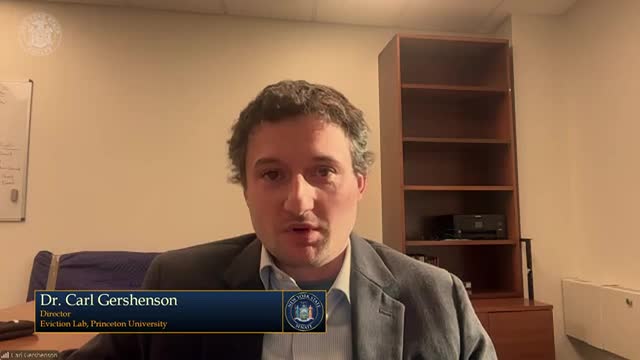New York eviction crisis reveals effectiveness of tenant protections and emergency assistance
February 18, 2025 | 2025 Legislature NY, New York
This article was created by AI summarizing key points discussed. AI makes mistakes, so for full details and context, please refer to the video of the full meeting. Please report any errors so we can fix them. Report an error »

New York State's eviction crisis took center stage at the recent Senate Joint Public Hearing, revealing a complex landscape of housing instability. A representative from a research center presented alarming statistics, highlighting that while New York has strong tenant protections, it still faces significant challenges with evictions, particularly in certain areas.
New York ranks as the third least affordable state in the nation, yet its eviction filing rate remains average compared to other states. Notably, New York City boasts an eviction filing rate three to four times lower than cities like Memphis and Richmond. However, this positive statistic masks troubling pockets of high eviction rates across the state, including Erie, Niagara, Albany, and The Bronx.
The representative emphasized the severe consequences of eviction in New York, stating that an eviction filing here is more devastating than in many other parts of the country. For instance, while Charlotte, North Carolina, has a much higher eviction filing rate, its vacancy rate is significantly greater, making it easier for evicted residents to find new housing. In contrast, The Bronx's vacancy rate is alarmingly low, leading to a high likelihood of homelessness following eviction.
A 2014 study indicated that 25% of households facing eviction in New York City ended up homeless, a figure believed to have risen since then. The financial implications of this crisis are staggering, with New York City reportedly spending around $271 per person per day on homelessness shelters alone. The representative argued that investing in eviction prevention measures, such as emergency rental assistance, could save the state substantial amounts in homelessness-related costs.
In conclusion, the hearing underscored the urgent need for effective eviction prevention strategies in New York. By prioritizing these measures, the state could not only alleviate the immediate suffering of families at risk of homelessness but also achieve significant long-term financial savings.
New York ranks as the third least affordable state in the nation, yet its eviction filing rate remains average compared to other states. Notably, New York City boasts an eviction filing rate three to four times lower than cities like Memphis and Richmond. However, this positive statistic masks troubling pockets of high eviction rates across the state, including Erie, Niagara, Albany, and The Bronx.
The representative emphasized the severe consequences of eviction in New York, stating that an eviction filing here is more devastating than in many other parts of the country. For instance, while Charlotte, North Carolina, has a much higher eviction filing rate, its vacancy rate is significantly greater, making it easier for evicted residents to find new housing. In contrast, The Bronx's vacancy rate is alarmingly low, leading to a high likelihood of homelessness following eviction.
A 2014 study indicated that 25% of households facing eviction in New York City ended up homeless, a figure believed to have risen since then. The financial implications of this crisis are staggering, with New York City reportedly spending around $271 per person per day on homelessness shelters alone. The representative argued that investing in eviction prevention measures, such as emergency rental assistance, could save the state substantial amounts in homelessness-related costs.
In conclusion, the hearing underscored the urgent need for effective eviction prevention strategies in New York. By prioritizing these measures, the state could not only alleviate the immediate suffering of families at risk of homelessness but also achieve significant long-term financial savings.
View full meeting
This article is based on a recent meeting—watch the full video and explore the complete transcript for deeper insights into the discussion.
View full meeting
